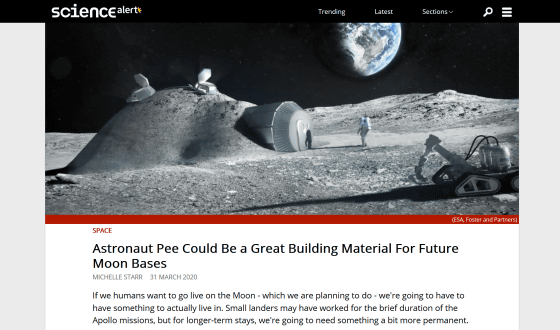Possibility of using `` astronaut's pee '' as a building material for lunar base emerges

NASA has announced the '
Utilization of urea as an accessible superplasticizer on the moon for lunar geopolymer mixtures-ScienceDirect
https://www.sciencedirect.com/science/article/pii/S0959652619340478
Study: Future astronauts could use their own urine to help build moon bases | Ars Technica
https://arstechnica.com/science/2020/03/study-future-astronauts-could-use-their-own-urine-to-help-build-moon-bases/
Astronaut Pee Could Be a Great Building Material For Future Moon Bases
https://www.sciencealert.com/future-moon-bases-could-be-made-out-of-astronaut-wee

It is said that it would cost $ 10,000 (about 1.1 million yen) for every pound (about 450 g) to bring base building materials from the earth to the moon. Transporting up to is not realistic. Therefore, researchers are studying 'using lunar resources to create building materials' and conducting
One promising building material for lunar bases is geopolymer concrete using lunar regolith. Geopolymers are fire-resistant, have low thermal conductivity, are expected to withstand extreme temperature changes in the moon, and prevent substances such as harmful radiation and acids.

In order to minimize the burden on people when building a lunar base, a construction approach using a 3D printer is being considered. In the approach using the 3D printer to build the material stacked in layers, it requires flexibility enough to extrude freely from the printer to the material, the geopolymer
To solve this problem, researchers in Norway, Spain, the Netherlands, and Italy have focused on urea in human pee. Since urea may work well as a plasticizer for geopolymer concrete, `` Isn't it possible to use the pee of an astronaut who went to the moon as a plasticizer for the geopolymer used to build lunar bases? 'And carried out research jointly with the European Space Agency (ESA) .
The researchers used urea-based plasticizers, polycarboxylate- based plasticizers, naphthalene- based plasticizers, and no plasticizers based on materials that mimic regolith Create a sample. Each sample was extruded with a 3D printer and checked for strength against weight and resistance to temperature changes.
The results showed that, compared to other samples, the samples using urea as a plasticizer and the samples using a naphthalene-based plasticizer had flexibility suitable for extrusion from 3D printers and higher strength. That Although the research team does not mention how to extract urea from urine, etc., it concludes that `` overall, urea shows promising properties as a plasticizer for geopolymer 3D printers '' .

Ramón Pamies , co-author of the dissertation, said, `` To make geopolymer concrete for the moon, we use lunar surfaces , such as regolith on the moon and water in some areas as ice. 'This study has shown that waste products such as the pee of an astronaut living on a lunar base can also be used to make geopolymer concrete.'
Related Posts:
in Science, Posted by log1h_ik







